Contents
- Planning
- Actions to guarantee mobility
- Railways
- Roads
- Airports and air transports
- Ports
- Housing
- Internationalisation
- Links
Planning
Within the framework of the overall lines of economic policy set by the Government of Spain and in accordance with the principles of rigorous and efficient public expenditure, the government programme for infrastructure, transport and housing is aimed at achieving the following objectives: territorial cohesion and structure, meeting the mobility and connectivity needs of citizens and productive fabric, improved public transport service quality and more efficient management.
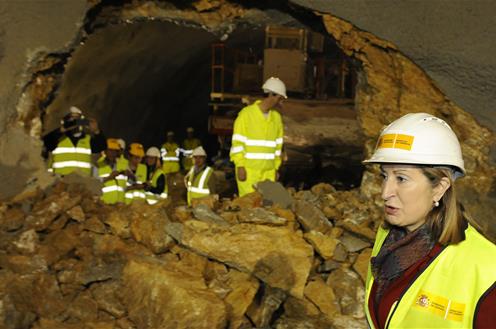 Cale del túnel de Callosa del Segura (Ministerio de Fomento)The Ministry of Public Works has defined the new integrated planning model for infrastructure, transport services and housing policy in the 2012-2024 Infrastructure, Transport and Housing Plan (Spanish acronym: PITVI), establishing the priorities and action programmes to be carried out by 2024 according to three principles: the utmost rigour in the selection of investments, respect for budgetary consolidation and greater adaptation to the real needs of society.
Cale del túnel de Callosa del Segura (Ministerio de Fomento)The Ministry of Public Works has defined the new integrated planning model for infrastructure, transport services and housing policy in the 2012-2024 Infrastructure, Transport and Housing Plan (Spanish acronym: PITVI), establishing the priorities and action programmes to be carried out by 2024 according to three principles: the utmost rigour in the selection of investments, respect for budgetary consolidation and greater adaptation to the real needs of society.
The Spanish Logistics Strategy has also been launched as a tool to boost the country's competitiveness in the field of logistics and freight transport through collaboration with local authorities and the productive sectors.
The Logistics Strategy has been designed to achieve improved performance from Spain as a logistics platform, both during the production phase and the commercial phase, by harnessing its strategic geographic location vis-à-vis the major global trade flows.
To support this plan, the Logistics Department was created and the Logistics Forum was launched in 2014.
In terms of housing and building renovation, this activity has been rebalanced to make it more sustainable and better suited to the public needs. In this regard, the new regulatory framework and the 2013-2016 State Plan have placed an emphasis on support for renting as a way to access housing and support for building renovation and the refurbishment of degraded urban areas as the best means to gradually recover the construction sector - one of the most severely affected by the economic crisis - and to improve living conditions for the public.
Actions to guarantee mobility
As part of its transport policy, the Ministry of Public Works allocates significant budgetary provisions to guaranteeing a sufficient level of mobility for people through the compensation of services declared as public service obligations and transport subsidies for non-mainland residents in the areas of rail, maritime and air transport. Specifically, almost 4.3 billion euros were allocated to this area in the period 2012-2015.
As regards residents in non-mainland territories (the Canary Islands, the Balearic Islands, Ceuta and Melilla), air and maritime transport ticket prices are discounted by 50% in order to facilitate citizen mobility in these territories. Specifically, over 1.48 billion euros were allocated to improving connectivity in these non-mainland territories in the period 2012-2015, 1.24 billion euros in air transport and 235 million euros in maritime transport. Furthermore, over 50 million air and maritime transport tickets were subsidised, reducing the price of over one million tickets each month.
Maritime service continuity was also guaranteed through new shipping line contracts (Algeciras-Ceuta, Malaga-Melilla and Almeria-Melilla, and Mainland-Canary Islands).
The Ministry of Public Works allocates approximately 600 million euros per year to guaranteeing the provision of railway services declared as Public Service Obligations, which are the suburban railway and medium-distance services. In the period 2012-2015 specifically, almost 4.3 billion euros were allocated to this area and over 1.12 billion euros are expected to be allocated to this area in 2016.
Railways
Spain's active railway network comprises over 15,500 kilometres of track, the vast majority of which (15,502 kilometres) is managed by ADIF. More than 3,200 kilometres (3,243 kilometres) are for high-speed trains.
Since 2012, 619 kilometres of high-speed lines were put into service: the Barcelona-Figueras line was finished, which completes the Madrid-Barcelona-French border high-speed connection and is one of the main routes connecting Spain to Europe; the Atlantic Corridor was also finished; and the Albacete-Alicante, Seville-Cadiz, Valladolid-Palencia-Leon and Olmedo-Zamora lines were opened.
The targets for the works completed and scheduled for the future are to complete the major strategic corridors, to propose technically viable solutions and to achieve significant travel time reductions between a significant number of provincial capitals.
Hence, Spain is the country with the most kilometres of high-speed rail in Europe and has the second-largest such network in the world, behind China. Around 400 high-speed trains travel around the network every day, carrying almost 96,000 passengers daily and arriving in over 132 Spanish cities. Spain currently has 47 high-speed stations in 27 provinces.
Furthermore, and thanks to gauge switchers, 97 cities enjoy the services brought by high-speed and conventional networks.
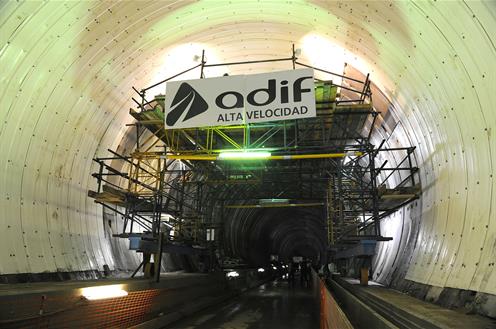 Obras de la Variante de Pajares (Ministerio de Fomento)From 1992 to december 2015, more than 230 million people have travelled on a pure high-speed trains in Spain.
Obras de la Variante de Pajares (Ministerio de Fomento)From 1992 to december 2015, more than 230 million people have travelled on a pure high-speed trains in Spain.
The experience gained over this time has converted Spain into a leader in the field of technology integration and railway interoperability. Spain is leading railway R&D+i in such fields as infrastructure, signalling, electrification and rolling stock.
The railways in Spain create almost 50,000 direct jobs and approximately 400,000 indirect jobs, while contributing about 1.3% of the gross value added of the Spanish economy.
The number of passengers who used trains operated by RENFE-Operadora in 2015 rose by 0.41% on the previous year to 465,2 million. According to the latest available data, which correspond to the running total from January to August 2016, 306.4 million passengers used RENFE trains (an increase of 1% on the same period last year), of which 23.2 travelled on board high-speed services (an increase of 5.1% on 2015).
The new high-speed services allow us to set a new target: to substantially increase the current number of AVE high-speed rail passengers.
The goal set by the Ministry of Public Works is for railways to be firmly established as an efficient and economically sustainable system, while remaining the preferred means of transport for large numbers of passengers and operating as the necessary means for the implementation of intermodal transport.
20.8 million tonnes of freight traffic were transported in 2015. To August 2016, this figure stands at 11,912,867 tonnes. The estimate made at the close of 2016 exceeds 18,300,000 tonnes.
The Ministry of Public Works has launched an action plan aimed at converting goods transportation by rail into the cornerstone of the logistics chain and to foster maritime-land intermodality. The Logistics Department at the ministry was created with this in mind and actions are being taken to harness the goods railway corridor infrastructures to their maximum potential.
Rail-port traffic totalled 15 million tonnes in 2015, which represents an increase of 10.97% on 2014. The total from January to July 2016 stood at 3.432.783 million tonnes, with a forecast for the year as a whole 6.5 million tonnes.
Furthermore, Spain has a suburban railway network of 2,790 kilometres of track providing service to 18 urban areas with 773 stations and a rolling stock of 748 trains that make an average on a labour day of 4,347 journeys. Suburban railway services are used by over 403 million users per year (data from 2015), which accounts for 86,7% of all train journeys. In order to improve both the infrastructure and the trains, a new Suburban Railway Plan has been launched (which implies scheduled investments in the period 2015-2018 that will exceed 1.5 billion euros).
Since 2012, and in terms of the regulatory framework, the State Agency for Railway Safety has been set up; the new Railway Circulation Regulations have been approved and the legislation governing care to the victims of accidents has been amended; and, finally, the new Railway Sector Act has been approved.
Roads
Spain's State Road Network is over 26,000 kilometres long, making it the longest network of highways and motorways in Europe (15,000 kilometres).
It is estimated that the tasks of construction, maintenance and operation of this network provide jobs to over 40,000 people in Spain.
Roads represent the main means of transport chosen by people in Spain to travel around the country, accounting for 90% of all transport, and also the main means of freight transport, accounting for 84%.
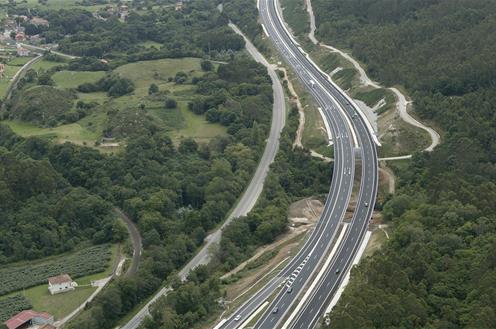 Autovía A-8 en Asturias (Ministerio de Fomento)Traffic on the State Road Network maintained the steady growth that began in 2013, especially in terms of heavy goods vehicles. The year 2015 saw cumulative growth of 4% in total traffic on the same period of 2014.
Autovía A-8 en Asturias (Ministerio de Fomento)Traffic on the State Road Network maintained the steady growth that began in 2013, especially in terms of heavy goods vehicles. The year 2015 saw cumulative growth of 4% in total traffic on the same period of 2014.
In the case of State Toll Highways, monthly traffic growth rates have seen a change in trend since July 2013. In 2014, total traffic on toll roads grew 2.4% compared to 2013 . And in 2015 it has increased by 6.4% compared to the same period of 2014.
Finally, in terms of heavy goods vehicle traffic, progress is more than clear in 2015 with growth of 8.1% on the toll motorway network and 5.4% on the toll-free State Highway Network.
Recent years have seen the implementation of new actions to improve the network. 910 new kilometres have been opened since 2012, an average of 202 kilometres per year. Of those, 622 kilometres correspond to new motorways, 127 to new conventional highways and 161 to capacity increases (new lanes and junction improvements).
During the course of this legislature, a number of major strategic road corridors have been completed, such as the Cantabrian Corridor (A-8), the Mediterranean Corridor (A-7) and the Ruta de la Plata (A-66), as well as the new section of the A-4 as it passes through Despeñaperros. In addition, one of the largest and most spectacular works of engineering built anywhere in the world was finished and opened to traffic: the new Bridge over the Bay of Cadiz.
A new model of more efficient and integrated maintenance has been also introduced.
To increase the use of motorways, improve business competitiveness and, in particular, improve driving conditions, road safety and avoid congestion on sections of conventional highway, a series of toll discounts were established and a pilot scheme was promoted to encourage the voluntary diversion of heavy goods traffic on certain sections of motorway.
Finally, in terms of the regulatory framework, the new Highway Act was approved to replace the old law dating back to 1988 in order to guarantee a response - in the present and the years to come - to the need for suitable and modern provision of the public highway service.
Airports and air transport
Another strategic sector for Spain is air transport, both due to its socio-economic impact (representing 5,9% of GDP) and its contribution in terms of connectivity, accessibility and territorial cohesion and structure. It is estimated that the 46 airports and two heliports managed by AENA, at which services are provided by over 6,000 companies, generate 146,500 direct jobs and 440,000 jobs in total; equal to 2% of the labour force.
In 2015, a total of 207.4 million passengers (an increase of 5.9% on 2014) used these airports and services, enabling AENA to consolidate itself as the leading airport manager in the world in terms of passenger numbers. Four out of five international visitors enter and leave Spain via the country's airports.
Furthermore, 1.9 million aircraft operations were recorded (3.8% more than in the previous year) and 715,000 tonnes of freight were transported (6% more than in 2014).
At the close of the first eight months of 2016, air traffic trends are showing satisfactory results. Passenger traffic data to 31 August show a figure of 155 million passengers across the Spanish airports network, which is an increase of 15 million passengers (up 10.9%) on the same period last year, and year-on-year traffic to 31 August 2016 of over 222 million passengers, with the expectation of operating 450 new routes during the course of this year.
 Inauguración de la ampliación del Aeropuerto de Vigo (Ministerio de Fomento)In recent years, AENA has undergone far-reaching changes that were necessary to ensure its viability and lay the foundations for future growth. This process has been characterised by efficiency in management and economic-financial sustainability. With these aims in mind, the following actions have been implemented: a comprehensive policy of austerity and investment streamlining; an airport efficiency plan to adapt schedules to demand at airports and heliports with fewer than 500,000 passengers; a policy aimed at increasing business activity; an airport marketing plan to attract new routes and increase air traffic; and a stable tariff agreement with the airlines, all in place for the next years.
Inauguración de la ampliación del Aeropuerto de Vigo (Ministerio de Fomento)In recent years, AENA has undergone far-reaching changes that were necessary to ensure its viability and lay the foundations for future growth. This process has been characterised by efficiency in management and economic-financial sustainability. With these aims in mind, the following actions have been implemented: a comprehensive policy of austerity and investment streamlining; an airport efficiency plan to adapt schedules to demand at airports and heliports with fewer than 500,000 passengers; a policy aimed at increasing business activity; an airport marketing plan to attract new routes and increase air traffic; and a stable tariff agreement with the airlines, all in place for the next years.
All these actions were carried out without affecting the quality of service or the safety of users, passengers and airlines.
These efforts are precisely what have enabled AENA to increase its value and welcome the entry of 49% of private capital, with the remaining 51% staying in the hands of the State. This process increases management efficiency and guarantees the airport network looking to the future.
Furthermore, AENA is successfully involved in the management of 16 airports in various other countries: 12 in Mexico (Grupo Aeroportuario del Pacífico, which includes the airports of Guadalajara, Tijuana, Puerto Vallarta and San José del Cabo, among others); 1 in Jamaica (Montego Bay); 2 in Colombia (Cali and Cartagena de Indias) and 1 in the United Kingdom (Luton). Between them, these airports were used by 52.9 million passengers in 2015, an increase of 21.7% on the same period last year (AENA began operating at Montego Bay Airport in Jamaica, via Grupo Aeroportuario del Pacífico, in April 2015).
Ports
The system of State-owned ports comprises 28 port authorities that manage a total of 47 economically significant port facilities under coordination by Puertos del Estado (the Spanish Port Authority)
Spain has the longest coastline of all EU countries, at 8,000 kilometres. Over 90% of Spanish borders are maritime. The Strait of Gibraltar is the second-busiest stretch of water in the world (after the English Channel). Over 198,000 ships passed through it in 2014 (2,000 more than in 2013). Including merchant ships and ferries, this is almost 300 boats per day. 60,000 ships sail around Finisterre every year.
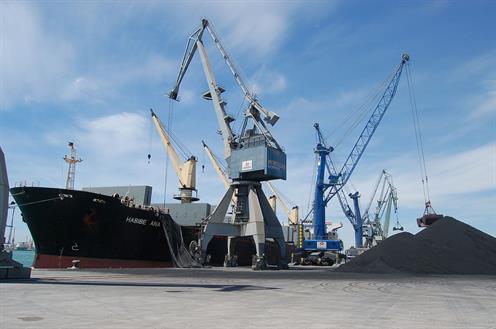 Pool MoncloaFurthermore, Spain is the third-largest European country (behind Germany and the Netherlands) in terms of container port movements and eleventh in the world. Three Spanish ports are among the 20 most important ports in Europe in terms of container freight traffic. In 2015, the Port of Rotterdam (Netherlands) published its Top-20 list of European docks in 2014 as regards this form of traffic and the ports of Algeciras, Valencia and Barcelona are all included on the list.
Pool MoncloaFurthermore, Spain is the third-largest European country (behind Germany and the Netherlands) in terms of container port movements and eleventh in the world. Three Spanish ports are among the 20 most important ports in Europe in terms of container freight traffic. In 2015, the Port of Rotterdam (Netherlands) published its Top-20 list of European docks in 2014 as regards this form of traffic and the ports of Algeciras, Valencia and Barcelona are all included on the list.
Furthermore, the 2015-2016 World Economic Forum competitiveness index on port infrastructure quality ranks Spain as twelvfth in the world, next to the United States and the United Kingdom.
In terms of economic impact, the Spanish port sector contributes 2.07% to GDP and accounts for 1.23% of all jobs. Ports create approximately 100,000 direct jobs, 60,000 indirect jobs and 116,000 induced jobs.
Port activity contributes an annual gross added value in excess of 10.7 billion euros to Spain. It is also a key link in the Spanish export chain. 60% of Spanish exports and 85% of Spanish imports pass through the country's ports, accounting for 53% of Spain's foreign trade with the European Union and 96% of foreign trade with non-EU countries. 86 out of every 100 vehicles made in Spain for export leave through a Spanish port.
An all-time traffic record was set in 2015 with 502 million tonnes of freight handled, representing an increase of 4.2% on the previous year. It should be noted that the last all-time record was set in 2007, a year in which 483.1 million tonnes were handled.
New all-time records were also set for the movement of liquid bulk (167.6 million tonnes), general freight (224.3 million), containers (14.2 million TEUs), regular line passenger traffic (21.5 million passengers) and cruise passenger traffic (8.4 million passengers).
As regards cruise passenger traffic, Spanish destinations have become regular stop-overs on all the routes covered by the various European cruise companies, with some Spanish ports now among the best destinations in the world. Hence, with 2.5 million cruise passengers in 2015, Barcelona was the leading European port and ranked 4th in the world as a home port. The Balearic Islands were visited by 1.7 million passengers and the Canary Islands by over 2.1 million.
During the first half of 2016, the network of economically significant ports moved 252 million tonnes. This is an increase of 2.5% on the same period last year.
Housing
In recent years, Spain has worked hard on its new land, housing and construction policy, the aims of which are to support renting as a means of access to housing, particularly for those on lower incomes, to promote building restoration and urban regeneration and renewal, and to improve energy efficiency with a view to obtaining better quality cities.
To achieve this, the Law on Flexibility Measures and Promotion of the Housing Rental Market and the Urban Restoration, Regeneration and Renovation Act were passed (subsequently mostly included in the new Recast Text of the Law on Land and Urban Redevelopment, approved by Royal Legislative Decree 7/2015, of 30 October).
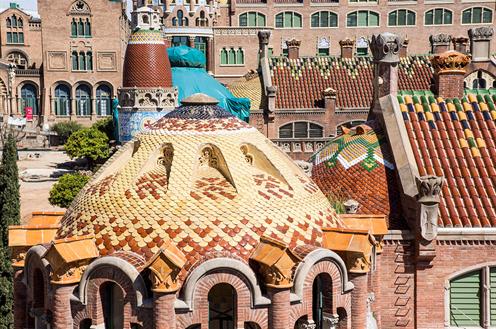 Actuación del 1,5% Cultural en el Hospital de la Santa Creu i Sant Pau, Barcelona (Ministerio de Fomento)Furthermore, the effective implementation of the 2013-2016 State Plan to Foster Housing Rental and Urban Restoration, Regeneration and Renovation and the direct financial aid provided thereunder constitute a decisive instrument for achieving progress along the path created by the aforementioned legislative provisions.
Actuación del 1,5% Cultural en el Hospital de la Santa Creu i Sant Pau, Barcelona (Ministerio de Fomento)Furthermore, the effective implementation of the 2013-2016 State Plan to Foster Housing Rental and Urban Restoration, Regeneration and Renovation and the direct financial aid provided thereunder constitute a decisive instrument for achieving progress along the path created by the aforementioned legislative provisions.
This new State Plan seeks a balance by combining the introduction of new financial aid for rental and renovation with maintenance of the financial aid that had been awarded in previous plans aimed at subsidising mortgage loans for the purchase of social housing. Similarly, it provides for an ordered transition aimed at facilitating the incorporation into the new programmes under this plan of beneficiaries of other financial aid awarded in previous plans which, due to the nature thereof, are compatible with the principles and objectives of the new plan.
The various lines of financial aid from the State Plan 2013-2016 are benefiting over 570,000 families, with a particular focus on social renting (with aid that will benefit some 240,000 households), and maintaining the subsidisation of interest charged to families that are paying a mortgage for the purchase of subsidised council housing (with some 250,000 beneficiaries).
Furthermore, the renovation of 80,000 homes was directly financed, the vast majority of which were occupied by people with few economic resources. Insofar as financial aid for renovation has been particularly focused on building accessibility, a large number of the beneficiaries were elderly people or people with mobility problems.
Furthermore, the aid aimed at supporting energy saving and efficiency measures made a considerable contribution to achieving the more general objective of combating environmental pollution and climate change.
All indicators in this sector point to a change in trend that is gaining momentum. For the first time since 2007, the "housing" heading within GDP grew in 2014 (1.3% in the third quarter of 2014), maintaining positive values throughout 2015. Similarly, the "construction" heading posted overall growth again, ending 2014 with growth of 3.4% on 2013 and 2015 with growth of 3.8%. An equally positive forecast is being maintained for 2016. This trend was reflected in the recovery of employment in the sector, which, for the first time in years, posted net growth in 2014 (approximately 50,000 jobs). This growth was maintained in 2015, with affiliation to the Social Security system under construction rising by 4.87% (668,084 jobs) and noteworthy job creation in real estate activities (up 8.3%).
In turn, the number of registered property transactions returned to positive figures. Hence, 104,530 properties were sold in April to June 2015, an increase of 13.9% on the same quarter of the previous year and a run of five consecutive quarters of growth to reach 107,838 transactions in the first quarter of 2016 (the highest level posted in a single quarter since the first quarter of 2011). Purchases made by overseas citizens remain stable and high (with 13.4% of the transactions completed in the first quarter of 2016). Similarly, there was noteworthy growth in the issue of new mortgages, with quarterly growth in the order of 19%.
After years of decline, property prices have posted their first positive rates since 2008 (0.3% in the third quarter of 2014), 1.2% in the second quarter of 2014 and 0.2% in the period between January and August 2016).
The rental market has taken off, with growth of approximately 2% per year with respect to the total number of occupied properties. Furthermore, this has been accompanied by highly stable and constantly rising gross profitability from 4.58% in the first quarter of 2015 to 6.1% in the second quarter of 2016.
Internationalisation
In the field of international relations, the Ministry of Public Works is working towards a three-fold objective: firstly, to strengthen cooperation and collaboration on transport, infrastructure and housing projects with other countries; secondly, to lead relations with the European Union (EU) on transport; and, thirdly, to support the internationalisation of Spanish companies (both public and private) and promote the "Spain" brand.
To achieve these goals, the Ministry of Public Works has supported the external action strategy of the Government of Spain by attending high-level meetings and various summits, as well as such multi-lateral forums as the International Civil Aviation Organisation (ICAO), the International Maritime Organisation (IMO) and the International Transport Forum (ITF).
Approval of the EU Guidelines on Designing the Trans-European Transport Networks and the so-called "Connecting Europe Facility" (CEF) Regulations is particularly significant as they establish the priorities and cofinancing system for the Trans-European Transport, Energy and Telecommunications Networks, and define - in terms of transport - new priority corridors, two of which (the Mediterranean and Atlantic Corridors) are being partially developed in Spain.
Neighbourly relations with France and Portugal in the field of cross-border transport infrastructures are essential for guaranteeing Spain's connectivity with the rest of Europe, in the case of France, and the mobility of Spanish citizens in general, especially those people who reside in neighbouring regions.
AVE
The Ministry of Public Works is involved in the Task Force that coordinates the Office of the High Commissioner of the Government for the 'Spain' Brand in order to give special relevance to matters of excellence in transport infrastructures and recognition of the leadership by Spain and its companies in this sector. Hence, Spain has once again reaffirmed its privileged position among the top ten countries in the world with the best infrastructures according to the latest Global Competitiveness Report from the Davos World Economic Forum, which describes Spain as "the country with the most competitive tourism sector thanks to its infrastructures" and its tenth position among the 148 countries in the Global Competitiveness Index.
Furthermore, the EU Transport Scoreboard puts Spain at the top of the ranking in terms of railway infrastructure quality. Spain comes in third as far as airports are concerned, fourth in terms of ports and fifth in Europe in terms of highways.
Currently, 10 major Spanish corporations appear among the top-100 contractors in the world and four of the top-10 global companies in transport infrastructure management (by number of concessions) are Spanish.
Spanish companies manage approximately 40% of the main transport concessions around the world. They also lead the global ranking in terms of volume of revenue from international contracts.
In 2015, the portfolio of international projects being managed by Spanish companies exceeded 88 billion euros.
The international infrastructure tenders awarded in 2015 involving Spanish companies amounted to 55.8 billion euros.
According to the most recent data (to 8 September 2016), international tenders already amount to over 31.12 billion euros this year, of which 10.06 billion euros correspond to concessions and 21.07 billion euros to traditional works.





